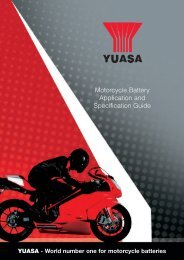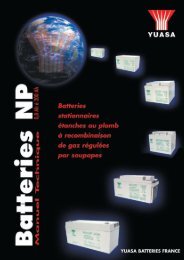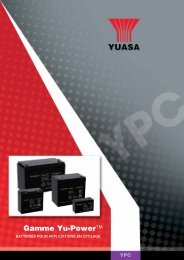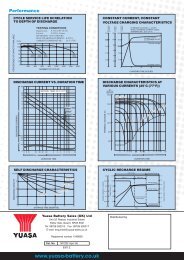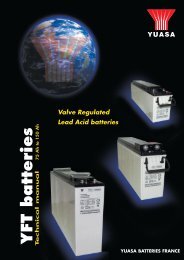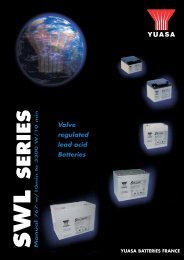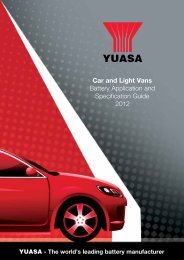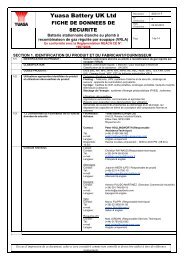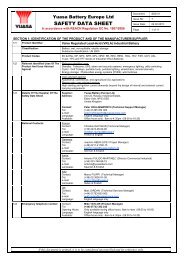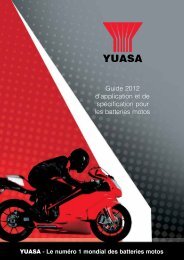YUASA - The world's leading battery manufacturer
YUASA - The world's leading battery manufacturer
YUASA - The world's leading battery manufacturer
Create successful ePaper yourself
Turn your PDF publications into a flip-book with our unique Google optimized e-Paper software.
All You Need To Know About Batteries continued<br />
Information<br />
MarineLine Batteries<br />
1. <strong>The</strong> MarineLine <strong>battery</strong> range has been designed with<br />
greater cyclic durability than the Leisureline range and<br />
principally designed for Hotel load usages on boats.<br />
F - Removing Batteries and Installing<br />
Batteries on Vehicles<br />
Removing Batteries<br />
1. It is good practice to tell the customer that, while you will do<br />
your best to keep the memory settings, it is possible these<br />
might be lost.<br />
2. Make sure the hand-brake is on, and that the car is in<br />
neutral or park. Switch off all electrical loads and remove<br />
the ignition key from the car. Note: On some cars, the doors<br />
will lock when the <strong>battery</strong> is disconnected so this is why the<br />
key should be removed from the car. Also switch off any<br />
non-factory-fitted alarms.<br />
3. Check that the cigar lighter is still working. If not, turn the<br />
ignition key to the auxiliary position. Install a Computer<br />
Memory Saver (CMS).<br />
4. Disconnect the earth-connector first. (This is normally the<br />
negative on modern vehicles). This can result in the loss of<br />
memory settings; please refer to the vehicle handbook.<br />
5. Disconnect the live-connector second. If a CMS is used, the<br />
connector will still remain live after it has been disconnected.<br />
To prevent the connector shorting against the car, place an<br />
insulator such as a rubber glove over the connector.<br />
6. Remove the hold-down clamps.<br />
Preparation of a Battery for Fitting<br />
1. Check that the <strong>battery</strong> has the correct polarity for the<br />
vehicle.<br />
2. Check that the <strong>battery</strong> has the correct height for the vehicle.<br />
(If a <strong>battery</strong> is too high, it can short out on the bonnet or the<br />
bottom of a seat, or it can damage the bonnet).<br />
3. It is good practice to place the old and new <strong>battery</strong> side by<br />
side to compare polarities, hold-downs and performancelevels.<br />
Some batteries have hold-downs at both the sides<br />
and ends. Only the ones used for securing the <strong>battery</strong> on<br />
the vehicle need to be checked.<br />
4. Check that the <strong>battery</strong> is clean and dry.<br />
5. Check that the vent-plugs or manifolds are firmly in position.<br />
6. Check that the <strong>battery</strong> has a voltage above 12.40V. If not,<br />
charge the <strong>battery</strong> or use another that has a voltage above<br />
12.40V.<br />
7. Ensure the 2 terminal caps are still fitted at this stage.<br />
Preparation of the Vehicle<br />
1. Clear away any items on the <strong>battery</strong>-tray which might<br />
damage the <strong>battery</strong>. (Placing a heavy <strong>battery</strong> on a piece of<br />
sharp grit can puncture the bottom of the <strong>battery</strong>).<br />
2. Check that the connectors, the hold-down clamps and the<br />
tray are clean and corrosion-free. (If there is any corrosion,<br />
hot water will instantly remove this). If there is severe<br />
corrosion which might affect the stability of the <strong>battery</strong> or<br />
has affected other parts of the engine compartment, have<br />
the vehicle checked by an authorised distributor.<br />
3. Check that the alternator drive-belt tension is correct. Refer<br />
to the vehicle handbook or service manual.<br />
4. It is recommended that the electrical system, and<br />
particularly the charging system, of the vehicle be checked<br />
to make sure it is operating correctly. Refer to the vehicle<br />
handbook or service manual.<br />
Installing the Battery<br />
1. Fit and tighten the hold-down clamps. <strong>The</strong>se should be<br />
tight enough to secure the <strong>battery</strong> and not allow it to move.<br />
DO NOT OVERTIGHTEN.<br />
2. Connect the live-connector first to the correct <strong>battery</strong>terminal<br />
(normally the positive) after removing the terminal<br />
cap. DO NOT OVERTIGHTEN.<br />
3. Connect the earth-connector to the other terminal after<br />
removing the terminal cap. DO NOT OVERTIGHTEN.<br />
4. Place the 2 terminal caps on the old <strong>battery</strong> that has been<br />
removed from the vehicle to avoid the possibility of shortcircuits.<br />
5. Replace onto the new <strong>battery</strong> any components that have<br />
been taken from the old <strong>battery</strong> such as exhaust tubes,<br />
vent-elbows, terminal covers, removable hold-down strips<br />
(widgets) etc.<br />
6. <strong>The</strong> use of petroleum-jelly (Vaseline) is not necessary on<br />
modern polypropylene batteries, but there is no<br />
disadvantage in using it. Smear lightly on the terminals. It is<br />
still recommended for hard-rubber batteries. Do not use<br />
grease.<br />
7. Remove the CMS.<br />
8. Start the engine<br />
9. For non-automotive applications, install the <strong>battery</strong> in line<br />
with the equipment-supplier’s recommendation.<br />
G - Charging Off-Vehicle<br />
Note: Please read before charging batteries<br />
• Do NOT charge a <strong>battery</strong> if its temperature is below 3°C as<br />
the electrolyte may have frozen.<br />
• Charging the <strong>battery</strong> on the vehicle is not recommended.<br />
• Refer to Section F for information about removing the<br />
<strong>battery</strong> from the vehicle.<br />
• ‘Sealed and AGM’ vehicle batteries should be charged only<br />
on constant potential chargers or ‘smart’ chargers. Do not<br />
charge on constant current chargers or boost chargers.<br />
‘Sealed’ vehicle batteries do not allow any access to the<br />
electrolyte, and so cannot be topped up. <strong>The</strong>re are no<br />
190




